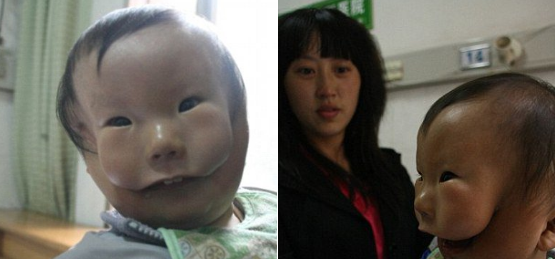Chinese Boy Born With 'Two Faces' Undergoes Surgical Procedures To Grow Facial Bones Normally: Transverse Facial Cleft Repair

A boy in China was born with a rare birth defect that has left his mother, and those surrounding him, in tears. Eight years ago, Zhao Huikang, also known as "Kang Kang," was born with transverse facial cleft, a deformity that gives him the appearance of having two faces, or a mask over his face. Doctors at the No. 163 Military Hospital in Changsha, capital of Hunan province, in China, have worked tirelessly to repair the boy's facial bones.
"Not only his soft tissues were damaged, broken and moved, his temporal bone, cheekbones, sphenoid bone and upper jaw were all damaged," said Dr. Wang Duquan, who performed Huikang's surgery, the DailyMail reported.
The heart-wrenching story of China's 'mask boy' https://t.co/z74NNDMMdq pic.twitter.com/nxjw0kV7yo
— Daily Mail Online (@MailOnline) January 13, 2017
Huikang's mother, Yi Lianxi, who was 23 at the time of her's son birth, was devastated and confused. Lianxi previously told Changsha Evening News the doctors at an unnamed hospital avoided showing her the baby after she gave birth. After repeatedly requesting to see her son, the doctors brought her the baby, and she recalled: "my whole body felt numb."
Read More: Girl With Tessier Facial Cleft Undergoes 3D-Printing Surgery To Reconstruct Face
Lianxi said she had undergone three ultrasound scans and one Doppler ultrasound scan during her pregnancy, in which no deformation had been detected.
Transverse facial cleft is a rare congenital anomaly that seldom occurs alone, and is frequently associated with deformities of the structure developing from the first and second branchial arches, according to an article in the Indian Journal of Plastic Surgery. The incidence of this condition varies from 1 in 60,000 to 1 in 300,000 live births.
With the help of public donations, the family was able to afford money for several operations to repair Huikang's face. On May 19 and September 1 in 2010, the boy underwent two operations. According to Duquan, both were successful, but Huikang would have to wait about 10 years to see if his facial bones would grow normally.
Seven years after his two initial surgeries, it's not yet known whether the boy is making progress. However, Huikang's story continues to resurface the Internet, as ET Today shared some photos of the story in December of last year.
There have been various surgical techniques reported for the repair of the transverse facial cleft using a straight-line closure, Z- or W-plasty, and local flaps, among other things. However, several problems remain such as deviation, distortion, and scars in the commissure (joint between two bones) and cheek. A 2010 study in the Journal of Plastic, Reconstructive, and Aesthetic Surgery found using an “oblique vermilion-mucosa incision and straight-line closure, the cross-overlap joining of the muscular bundles at an angle of 90 degrees, and the horizontal straight-line skin closure with a small Z-plasty lateral to the nasolabial fold” can construct a symmetrical and natural commissure without obvious scarring.
It's not clear whether Huikang was exposed to any of these treatments.
See Also:
Neglecting Folic Acid may Increase Risk of Facial Defects in Babies
'Ambassadog' Lentil, Born With Cleft Palate and Lip, Helps Kids with Facial Differences Feel Normal



























